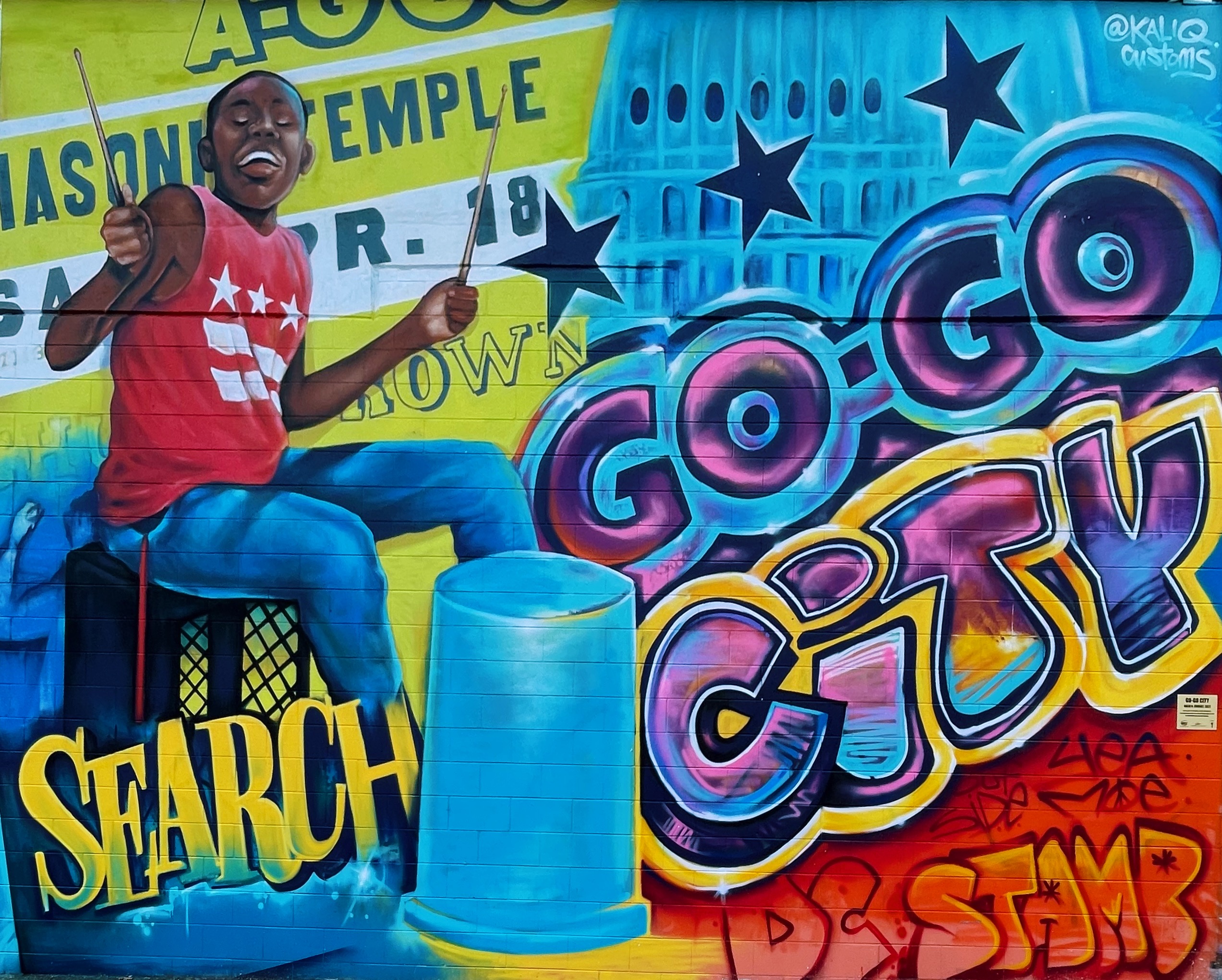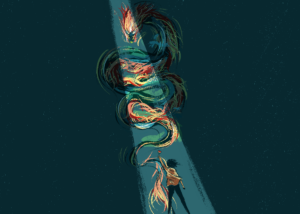Ronald Moten grew up on go-go music. When he was young, he would sneak out at night to see the go-go bands in Washington, D.C., despite knowing his grandmother would be waiting at the door when he got home. Decades later, the music that defined his childhood compelled him to action when his friend Donald Campbell called to tell him someone was trying to shut off the go-go.
Go-go has been described as D.C.’s indigenous musical genre, first surfacing in the 1970s with roots in funk, hip-hop, and Afro-Latin beats. Go-go originated primarily with Black D.C. artists, and its historical significance to D.C.’s Black community has endured. Fundamentally, go-go music is D.C. culture. And, like many staples of Black culture in the nation’s rapidly gentrifying capital, go-go is under threat of erasure.
In 2019, Campbell’s phone call to Moten launched a movement. For almost 25 years, Campbell had been playing go-go music from the speakers outside his Metro PCS store in the historically Black U Street neighborhood. When residents in a nearby luxury apartment complex threatened to sue, T-Mobile, the corporate owner of Metro PCS, ordered him to turn the music off.
“He was like, ‘Moe, I need your help,’’’ Moten said. “I was like, ‘What’s going on?’ He’s like, ‘They made me cut the music off.’”
Almost instantly, thousands of D.C. residents took to the streets. Except they didn’t just march. They danced, scored by go-go bands playing in front of the store at 7th Street and Florida Avenue NW. The hashtag #DontMuteDC evolved into a rallying cry against the policing of the sounds and spaces of D.C.’s Black culture, as well as the harms of rapid gentrification and resulting displacement. To draw national attention, Moten and public scholar Natalie Hopkinson launched an April 8 petition, “Don’t Mute DC’s Go-Go Music and Culture,” calling go-go the “soul and heartbeat of Washington.”
“When they actually suppressed it and took it away and silenced the music, it was sort of like a clarifying moment for people, especially for people in D.C., long-time native Washingtonians, about what’s at stake and just how audacious the attack is on D.C. culture,” Hopkinson said in an interview with the Voice.
The protest represents a larger tension around the demographic and cultural overhaul of D.C.’s historically Black neighborhoods by whiter and wealthier residents. Gentrification involves the movement of wealthier (and often white) residents into neighborhoods with lower housing costs, forcing up costs of living and driving out low-income residents, who are disproportionately people of color. The District is one of the most intensely gentrified cities in the United States.
Over the past decade, D.C. lost its long-held status as one of the nation’s major majority-Black cities, as the city’s Black population fell by nearly 10,000 residents. A recent study showed that the neighborhoods most heavily impacted by gentrification include Marshall Heights and Anacostia, which are in the predominantly Black areas of Ward 7 (91.74 percent Black) and Ward 8 (91.84 percent Black). And Ward 1, where the U Street area is situated and Don’t Mute D.C. began, is following suit, now newly majority white. Once known as Black Broadway, the neighborhood around the 14th and U Street corridors has become notable as one of the most visibly gentrifying areas in the city.
What was once a center for Black arts, culture, and economic power has been gentrified to a breaking point, and nothing exemplifies that more than residents in new, expensive apartments threatening to sue their neighbors over go-go being played on the street.
More than 80,000 signatures later, with supporters from all 50 states and 94 countries, the music at Metro PCS returned. And as go-go played on, the community who rallied behind Don’t Mute D.C. furthered the fight against gentrification.
Months after the go-go music returned to the corner of 7th Street and Florida Avenue, Ward 5 D.C. Councilmember Kenyan McDuffie introduced the “Go-Go Official Music of the District of Columbia Designation Act of 2019.” The bill was signed into legislation by D.C. Mayor Muriel Bowser in 2020, making go-go the official music of the nation’s capital. And, in 2019, Bowser declared the week of Nov. 17 to Nov. 23 “Go-Go Awareness Week.”
“Making [go-go] the official music of the District of Columbia was really a no-brainer, but it wouldn’t have happened if you all hadn’t pushed back and organized,” McDuffie said at a panel during the second annual Go-Go Preservation Week in November of 2021. “That organization was so powerful; imagine if it sustained?”
The silencing of go-go was never just about the music, and the movement has broadened its mission. Don’t Mute D.C. took their methodology of protest and petition to a plethora of racially-based injustices in the District, expanding their influence into realms of public policy, preservation, and further activism. “We were able to activate the music around a bunch of other real serious issues,” Hopkinson said.
When D.C. City Council threatened United Medical Center, the only hospital serving Wards 7 and 8, with enormous budget cuts, Don’t Mute D.C. took to the streets to protest, and pushed for $22 million in funding to be restored. The movement also helped with a $53 million modernization of Banneker Academic High School, which serves mostly Black and Hispanic students, and its move to Shaw.
“Without our culture, this city is nothing,” Moten said at a panel discussion about the future of Go-go at the Martin Luther King Jr. Memorial Library during Go-Go Preservation Week 2021.
“Our spirit is in this music and we gotta fight. We gotta make sure Black people have a place in this city,” Moten said at the panel. The library also hosted a performance by iconic 1970s go-go band Rare Essence and presented self-guided tours of the D.C. Public Library go-go exhibit on Nov. 20.
Reasserting the relevance and necessity of Don’t Mute D.C.’s fight against Black erasure in the District, the speakers on the panel at the library made it clear: The syncopated rhythms and drum beats of go-go are the heartbeat of D.C.
“Go-go is us. How we are doing is how go-go is doing,” Shanel O. Anthony, a member of the Board of Trustees for the D.C. Public Library, said. “We’re still here, go-go is still here.”
But with waning publicity, the future of go-go is not as clear. The Go-Go Museum, located in Anacostia, serves a dual role of community hub and cultural education center, providing an introduction to go-go with hopes to cement its legacy. Moten and Hopkinson hope that the cultural preservation work of activists and public scholars is institutionalized.
Asked what is needed for go-go to be preserved, panelists seated in the newly renovated auditorium pointed to their surroundings. “It’s essential that the library play a role in the archiving of that music, that’s what libraries do. You come here to learn, so why wouldn’t you come here to learn about our music?” Anthony said.
The D.C. Public Library has assisted in the archival preservation of go-go at an institutional level, and the hope is that the work happening there will contribute to a broader public education of the District’s cultural touchstone. At the Martin Luther King Jr. Memorial Library, a small go-go exhibit on the 4th floor has a collection of memorabilia and documents from the library’s go-go archive.
“It’s important because of its contribution to the narrative of the city,” archivist Derek Gray said. Gray has been archiving go-go for over a decade, and as one of the few archivists at the D.C. Public Library, is part of a centralized push to teach people about the importance of go-go in the nation’s capital through shared historical records.
The go-go archives were formally established in May of 2012, following the death of Chuck Brown, called the “Godfather of Go-Go.” While archival documentation can seem like an overly scholarly way to engage with material, Gray wants the go-go archives to be an interactive, low-barrier experience for anyone who visits the library, Washingtonian or not. “I want to make it accessible to all types of people,” he said.
As much as the archival work at the D.C. Public Library is an outward-facing quest to educate, developing a collection is an inward service to the go-go diaspora. Drawing directly from D.C. locals, the archives are a work of community preservation and documenting the work of Don’t Mute D.C. activists.
Hopkinson, who also serves as an assistant professor at Howard University, has partnered with the D.C. Public Library to build out the archives through oral history, a cornerstone of go-go documentation. To develop similar projects like Traditional Arts D.C., a folklife center aspiring to highlight D.C.’s Black and Indigenous cultures, Hopkinson and her students have been equipping community members with the tools to cement their own history.
“We want to get as many people empowered as possible to be able to document this history,” Hopkinson said. “The impulse to preserve culture is not something that comes from me or from any institution. There are these cultural workers who have always been doing this work.”
Bryan Jenkins, a doctoral student at Howard who has worked with Hopkinson on many projects, pointed to the importance of folklife centers in their efforts to document the importance of cultural forms like go-go.
“D.C. is known as Chocolate City, known as a very Black city, and yet there’s a lot of culture here that you think would be front and center in some of our institutions,” Jenkins said, “but it’s not really and it really hasn’t been until recent years.” The popular narrative of the District is one that repeatedly ignores its Black residents, focusing instead on the bureaucratic activities on the Hill, he said. “I hear some of these conversations and it’s just completely missing the go-go and the Black history.”
According to Jenkins, it is critical that transplants moving into the District educate themselves on go-go. But more than that, new and long-term residents must value the place that D.C. culture, and Black culture, holds in the history and future of the city. “It’s respect, is the first thing I’d say when you come in,” Jenkins said.
Nearly three years since Don’t Mute D.C. rallied people in the fight against gentrification, the urgency remains, even if some can’t see it. “The fact that we have to tell people why it’s important is part of the reason why it’s so important,” Jenkins said. “I think it’s very easy for certain causes and certain issues, in particular with gentrification, to just be out of sight and out of mind for other people.”
And for the people who study it and celebrate it, the perseverance of go-go is more than a representation of D.C.’s fight against gentrification. To many like Hopkinson, go-go is a blessing.
“It’s not just music. It’s culture, it’s a way of life, it’s equity, it’s health equity, it’s all the things that we’ve been working on, education and policy, it’s everything,” she said. “The more people can get engaged, the better it’s going to be.”






Pardon me, Go Go predates Hip Hop and has no “roots” in the latter. Please correct that piece of misinformation